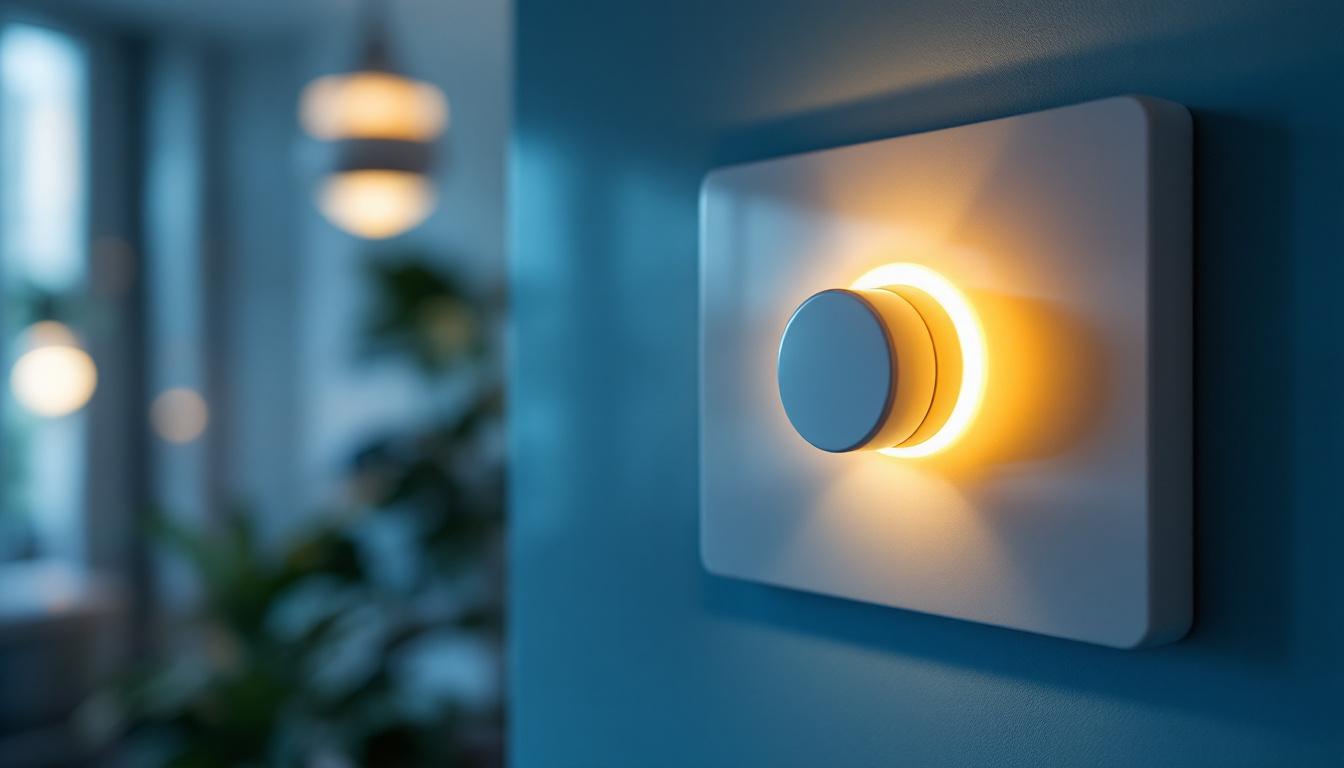
As a lighting contractor, understanding the intricacies of dimmer wall switches is essential for providing clients with optimal lighting solutions. These devices not only enhance the ambiance of a space but also contribute to energy efficiency. This article delves into the science behind dimmer switches, their types, installation considerations, and troubleshooting tips, ensuring that contractors are well-equipped to handle various lighting projects.
A dimmer wall switch is a device that allows users to adjust the brightness of lighting fixtures. Unlike traditional switches that merely turn lights on or off, dimmers provide flexibility in controlling light levels, which can significantly influence the mood and functionality of a space. This capability is particularly valuable in residential and commercial settings where lighting needs may vary throughout the day. For example, in a home theater, dimmers can create a cinematic experience by lowering the lights to just the right level, while in a workspace, brighter lighting may be necessary to enhance focus and productivity.
At its core, a dimmer switch functions by altering the voltage and current supplied to the light fixture. This adjustment is achieved through various technologies, including resistive, capacitive, and electronic methods. Understanding these technologies is vital for lighting contractors, as they determine the compatibility of dimmers with different types of light bulbs and fixtures. For instance, LED bulbs require specific types of dimmers to function correctly without flickering, making it essential for homeowners to consult with professionals when selecting the right dimmer for their needs.
Incorporating dimmer switches into lighting designs offers numerous advantages. One of the primary benefits is energy savings. By reducing the brightness of lights, users can decrease energy consumption, leading to lower electricity bills. This is particularly advantageous in commercial spaces where lighting can account for a significant portion of energy use. Moreover, dimmers can extend the lifespan of light bulbs, as operating them at lower levels reduces wear and tear, which is a compelling reason for both homeowners and business owners to make the switch.
Additionally, dimmers enhance the aesthetic appeal of a space. They allow for customizable lighting scenarios, enabling users to create the perfect ambiance for various activities, from intimate dinners to lively gatherings. This versatility can be a selling point for contractors when discussing options with clients. Beyond mere aesthetics, dimmers also play a crucial role in improving the functionality of spaces. For example, in a restaurant, the ability to adjust lighting can help set the mood for different times of day, transitioning from bright, energizing light during lunch hours to soft, warm lighting in the evening, thereby enhancing the overall dining experience. Furthermore, with the advent of smart home technology, many dimmer switches now offer remote control features, allowing users to adjust lighting from their smartphones or through voice commands, adding an extra layer of convenience and modernity to any space.
Understanding the different types of dimmer switches available is crucial for selecting the right one for a specific application. Each type has its unique features and compatibility considerations, making it essential for contractors to be well-informed.
Incandescent and halogen dimmers are among the most traditional types. These devices work by using a variable resistor to adjust the voltage supplied to the bulb. They are compatible with standard incandescent and halogen bulbs, providing smooth dimming capabilities. However, these dimmers can generate heat, which may affect their longevity and efficiency. Additionally, these dimmers are often favored for their simplicity and reliability, making them a go-to choice for many residential settings. When using these dimmers, it’s important to consider the wattage limits, as exceeding these can lead to overheating and potential hazards.
As energy-efficient lighting options have gained popularity, LED and CFL dimmers have emerged to accommodate these technologies. Unlike traditional dimmers, these devices utilize electronic circuits to control the current flowing to the light source. It is crucial for contractors to ensure that the dimmer is specifically labeled as compatible with LED and CFL bulbs, as not all dimmers work with these energy-efficient options. Furthermore, LED and CFL dimmers can offer a wider range of dimming capabilities, allowing for finer adjustments in brightness. This is particularly beneficial in settings where ambiance is key, such as dining rooms or home theaters. Additionally, the reduced energy consumption of these bulbs means that using compatible dimmers can lead to significant savings on electricity bills over time.
Smart dimmers represent the latest advancement in lighting control technology. These devices can be integrated into smart home systems, allowing users to control lighting through mobile apps or voice commands. Smart dimmers often come with additional features, such as scheduling and scene-setting capabilities, making them an attractive choice for tech-savvy clients. However, contractors should be familiar with the installation and configuration processes associated with smart dimmers to provide comprehensive service. Moreover, many smart dimmers can be programmed to sync with other smart devices, such as motion sensors and smart thermostats, creating a cohesive and energy-efficient home environment. This interconnectedness not only enhances convenience but also contributes to the overall security of the home, as users can simulate occupancy by scheduling lights to turn on and off at specific times. As the demand for smart home technology continues to rise, understanding the nuances of smart dimmers will be an invaluable asset for contractors looking to stay ahead in the market.
Proper installation of dimmer switches is critical to ensure functionality and safety. Lighting contractors must adhere to specific guidelines and best practices to avoid common pitfalls associated with dimmer installation.
Before installing a dimmer switch, it is essential to assess the electrical compatibility of the existing wiring and the dimmer itself. Contractors should verify the voltage rating and ensure that the dimmer can handle the load of the connected fixtures. Overloading a dimmer can lead to overheating and potential failure, posing safety hazards.
Understanding the wiring configuration is vital for a successful installation. Most dimmers require a three-wire setup, including a line, load, and ground wire. Contractors should familiarize themselves with local electrical codes and regulations to ensure compliance during installation. Additionally, proper labeling and organization of wires can streamline the installation process and reduce the risk of errors.
After installation, testing the dimmer switch is crucial to ensure it operates as intended. Contractors should check for smooth dimming across the entire range and verify that there are no flickering or buzzing sounds. If issues arise, calibration may be necessary, especially with LED and CFL dimmers, to achieve optimal performance.
Even with careful installation, issues may arise with dimmer switches. Being able to troubleshoot these problems efficiently can save time and enhance client satisfaction. Here are some common issues and their potential solutions.
Flickering lights can be a frustrating problem for clients. This issue may stem from incompatible bulbs or a faulty dimmer switch. Contractors should first ensure that the bulbs used are compatible with the dimmer. If the bulbs are appropriate, replacing the dimmer switch may be necessary to resolve the flickering.
Buzzing or humming sounds from dimmer switches are often indicative of poor compatibility with the connected lighting. This issue is particularly common with LED and CFL bulbs. Contractors should recommend high-quality dimmers designed specifically for these types of bulbs to minimize noise. Additionally, checking the load on the dimmer can help identify if it is overloaded, which may also contribute to the noise.
Inconsistent dimming performance can be frustrating for users. This issue can arise from various factors, including the type of bulbs used, the quality of the dimmer, or even the wiring configuration. Contractors should conduct a thorough inspection of the installation, ensuring that all components are compatible and functioning correctly. If problems persist, replacing the dimmer with a higher-quality model may be necessary.
As energy efficiency becomes increasingly important in the lighting industry, dimmer switches play a significant role in promoting sustainable practices. By allowing users to adjust lighting levels, dimmers contribute to reduced energy consumption and lower carbon footprints.
Lighting contractors can educate clients on the benefits of using dimmer switches as part of an overall energy-saving strategy. Encouraging the use of dimmers in conjunction with energy-efficient bulbs can maximize savings and enhance the environmental benefits of a lighting system. Additionally, contractors can highlight the potential for reduced wear and tear on lighting fixtures, leading to longer lifespans and decreased waste.
Many utility companies offer incentives and rebates for energy-efficient upgrades, including the installation of dimmer switches. Contractors should stay informed about available programs in their area and communicate these opportunities to clients. This not only promotes energy efficiency but also enhances the overall value of the lighting project.
Understanding the science behind dimmer wall switches is essential for lighting contractors aiming to provide exceptional service and solutions to their clients. By grasping the different types of dimmers, installation considerations, troubleshooting techniques, and the benefits of energy efficiency, contractors can enhance their expertise and elevate their projects.
As the demand for customizable and energy-efficient lighting continues to grow, staying informed about the latest advancements in dimmer technology will empower contractors to meet client needs effectively. Embracing this knowledge will not only improve project outcomes but also contribute to a more sustainable future in the lighting industry.
Ready to take your lighting projects to the next level? At LumenWholesale, we provide lighting contractors like you with the highest quality, spec-grade dimmer switches and lighting products at unbeatable wholesale prices. Say goodbye to local distributor markups and hello to our extensive selection that meets rigorous industry standards. With free shipping on bulk orders, you can trust that you’re getting premium lighting solutions at the best value, without any hidden fees. Elevate your lighting installations with the perfect blend of quality, affordability, and convenience. Visit LumenWholesale today and experience Wholesale Lighting at the Best Value for all your project needs.

Discover how 8 ft fluorescent lamps can be the key to future-proofing your lighting projects.

Discover how overhead lighting is transforming the landscape for lighting contractors, boosting efficiency, and enhancing project outcomes.

Discover essential tips for lighting contractors on modern fluorescent lights, including energy savings, installation best practices, and industry insights to boost your projects..

Explore innovative cost-saving strategies for lighting contractors focusing on dimming light switches.